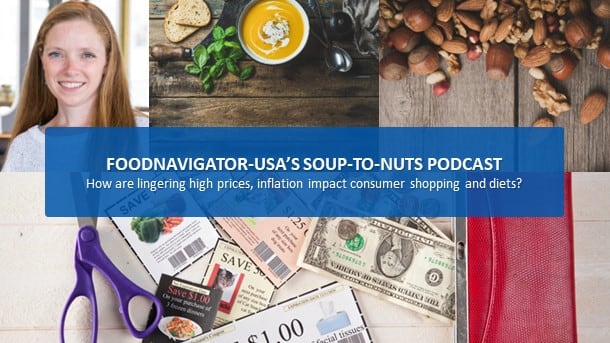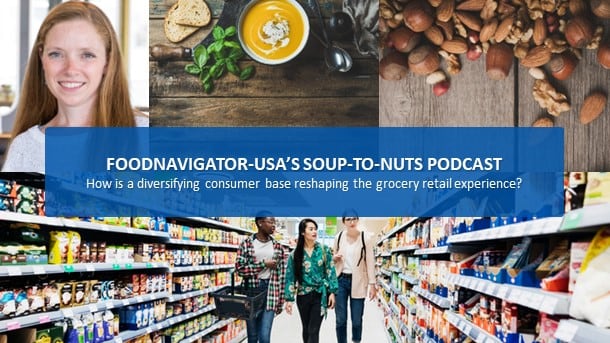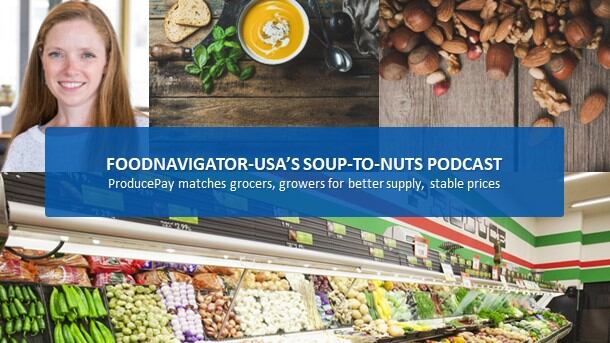According to a report released last week by consumer research platform Attest, roughly 60% of Americans are struggling to afford food as price hikes to offset inflation limit what and how much they can buy and where they shop.
Recognizing that many consumers feel squeezed and facing volume shortfalls as a result, CPG makers and retailers are rethinking their marketing strategies with some opting for more promotions and others playing the long-game and holding prices steady even if they lose market share in the short term.
In this episode of FoodNavigator-USA’s Soup-To-Nuts Podcast, Attest Chief Commercial Officer Todd Fellerman shares insights from the consumer research company’s report published Sept. 13 ‘Facing up to food insecurity: A guide to changing consumer behavior for F&B brands and retailers.’ He explains who is struggling to afford food, how this impacts their shopping habits and loyalty. He also shines a light on how people across socio-economic and regions approach cooking in the current economic environment and what they are looking for from brands as they balance both their budgets and increasingly busy lives. And finally, he offers tips for attracting and maintaining consumers in the current landscape.
Inflation may be slowing, but grocery prices aren’t dropping
According to data released last week by the Labor Department, US consumer prices for food consumed at home ticked up 0.2% in August over the prior month – a touch slower than the 0.3% month-over-month increase in July but a reversal from the slight decline to flat rates month-over-moth since February.
These numbers, while still not where most would like them to be, are far lower than the double-digit year-over-year increases of last summer – suggesting that the economy is slowly recovering as commodity costs and inputs moderate slightly. But, as Fellerman notes, there is a lag in the response to inflation across the landscape, including in consumers’ pay checks and the prices they see on store shelves.
“Where overall inflation feels like it's slowed down, we've seen that when it comes down to paying at the pump paying at the grocery store, a lot of consumers are still struggling, and on the whole, people are having to make those hard choices,” he said.
Shoppers are buying less food, sacrificing nutrition for calorie density
Fellerman says for grocery shoppers, those hard choices often center around less quantity and lower quality food.
“[Consumers are] seeing that their dollar is not going as far at the register, and they’re trying to find way to [stretch it],” Fellerman said, adding, “the other interesting thing we found within the research speaks to the fact that nutrition for certain folks in certain segments of the US is becoming less and less of a thing because they’re saying, ‘I don’t want to look at nutrition. I’m trying to just find a way to keep that food on the table in the most frequent way possible.’”
While Attest’s research shows the impact of inflation and higher grocery prices is hitting consumers across the board with less than half of the population reporting they can comfortably afford food, Fellerman notes that the brunt of the impact is falling on Gen X and less affluent shoppers.
Based on these findings, Fellerman advises brands and retailers to tailor their marketing and promotional efforts regionally and generationally. For example, Attest suggests in the report that Millennials, who have the highest shopping frequency, are most responsive to in-store promotions, while more affluent shoppers who are willing to visit multiple stores to find deals will respond well to coupons.
Consumers continue to eat at home, engage with videos for inspiration
Fellerman notes a silverling for grocery stores and CPG brands from consumers tightening their food budgets is that more people are cooking at home and cooking from scratch – creating opportunities for retailers and manufacturers to engage with shoppers around the joy of cooking.
“We actually see that cooking at home [is] something that almost every stripe of an American – socioeconomically, regionally – are doing, and that is a positive in some sense,” Fellerman said.
Fellerman says one of the best ways for retailers and food brands to tap into consumers’ joy of cooking is through digital recipes and video tutorials on platforms like TikTok to teach consumers how to use products and make enjoyable meals at home.
In addition, he calls out the power of prepared foods as a way to draw in younger shoppers who feel strapped for time and older shoppers who have more income.
Offer inspiration within reach
On that note, Fellerman also cautions brands and retailers to make recipes accessible not just from a technical standpoint, but also a financial one, which might mean incorporating ways for consumers to stretch a meal or prepare something that is nutritious but also affordable.
He also recommends brands diversify where they advertise and offer promotions as a head nod to consumers shopping across channels and buying food places where they previously might not have shopped.
To learn more about how the economy is influencing consumer behavior and how retailers and brands in turn should adjust innovation and marketing strategies, visit askattest.com and check out the full report released this week: ‘Facing up to food insecurity: A guide to changing consumer behavior for F&B brands and retailers.’




